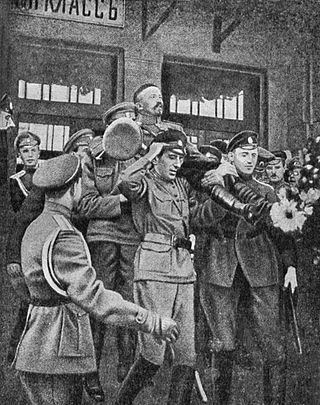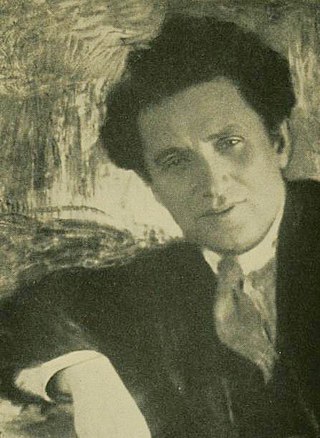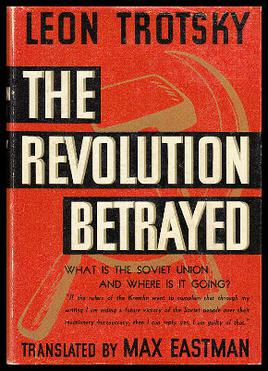Related Research Articles

Lev Davidovich Bronstein, better known as Leon Trotsky, was a Russian revolutionary, Soviet politician, journalist, and political theorist. He was a central figure in the 1905 Revolution, October Revolution, Russian Civil War, and the establishment of the Soviet Union. Alongside Vladimir Lenin, Trotsky was widely considered the most prominent Soviet figure and was de facto second-in-command during the early years of the Russian Soviet Republic. Ideologically a Marxist and a Leninist, his thought and writings inspired a school of Marxism known as Trotskyism.

The October Revolution, also known as the Great October Socialist Revolution, October coup, or Bolshevik coup was a revolution in Russia led by the Bolshevik Party of Vladimir Lenin that was a key moment in the larger Russian Revolution of 1917–1923. It was the second revolutionary change of government in Russia in 1917. It took place through an armed insurrection in Petrograd on 7 November 1917 [O.S. 25 October]. It was the precipitating event of the Russian Civil War.

The Russian Revolution was a period of political and social change in the Russian Empire, starting in 1917. This period saw Russia abolish its monarchy and adopt a socialist form of government following two successive revolutions and a bloody civil war. The Russian Revolution can also be seen as the precursor for the other European revolutions that occurred during or in the aftermath of World War I, such as the German Revolution of 1918–1919.

The ten years 1917–1927 saw a radical transformation of the Russian Empire into a socialist state, the Soviet Union. Soviet Russia covers 1917–1922 and Soviet Union covers the years 1922 to 1991. After the Russian Civil War (1917–1923), the Bolsheviks took control. They were dedicated to a version of Marxism developed by Vladimir Lenin. It promised the workers would rise, destroy capitalism, and create a socialist society under the leadership of the Communist Party of the Soviet Union. The awkward problem, regarding Marxist revolutionary theory, was the small proletariat, in an overwhelmingly peasant society with limited industry and a very small middle class. Following the February Revolution in 1917 that deposed Nicholas II of Russia, a short-lived provisional government gave way to Bolsheviks in the October Revolution. The Bolshevik Party was renamed the Russian Communist Party (RCP).

The Kornilov affair, or the Kornilov putsch, was an attempted military coup d'état by the commander-in-chief of the Russian Army, General Lavr Kornilov, from 10 to 13 September 1917, against the Russian Provisional Government headed by Aleksander Kerensky and the Petrograd Soviet of Soldiers' and Workers' Deputies. The exact details and motivations of the Kornilov affair are unconfirmed due to the general confusion of all parties involved. Many historians have had to piece together varied historical accounts as a result.
The history of the Communist Party of the Soviet Union was generally perceived as covering that of the Bolshevik faction of the Russian Social Democratic Labour Party from which it evolved. In 1912, the party formally split, and the predecessor to the Communist Party of the Soviet Union became a distinct entity. Its history since then can roughly be divided into the following periods:
The Kerensky–Krasnov uprising was an attempt by Alexander Kerensky to crush the October Revolution and regain power after the Bolsheviks overthrew his government in Petrograd. It took place between 8 and 13 November 1917 [O.S. 26 and 31 October].

Grigori Yakovlevich Sokolnikov was a Russian Old Bolshevik revolutionary, economist, and Soviet politician.

Vladimir Alexandrovich Antonov-Ovseenko, real surname Ovseenko, party aliases 'Bayonet' (Штык) and 'Nikita' (Никита), literary pseudonym A. Galsky, was a prominent Bolshevik leader, Soviet statesman, military commander, and diplomat.
The Executive Committee of the Petrograd Soviet, commonly known as the Petrograd Soviet Ispolkom was a self-appointed executive committee of the Petrograd Soviet. As an antagonist of the Russian Provisional Government, after the 1917 February Revolution in Russia, the Ispolkom became a second center of power. It was dissolved during the Bolshevik October Revolution later that year.

The July Days were a period of unrest in Petrograd, Russia, between 16–20 July [O.S. 3–7 July] 1917. It was characterised by spontaneous armed demonstrations by soldiers, sailors, and industrial workers engaged against the Russian Provisional Government. The demonstrations were angrier and more violent than those during the February Revolution months earlier.

Andrei Sergeyevich Bubnov was a Russian Bolshevik revolutionary leader, one of Bolshevik leaders in Ukraine, Soviet politician and military leader and member of the Left Opposition.

Ivar Tenisovich Smilga was a Latvian Bolshevik leader, Soviet politician and economist. He was a member of the Left Opposition in the Soviet Union.

Joseph Stalin started his career as a radical student, becoming a robber, gangster as well as an influential member and eventually the leader of the Bolshevik faction of the Russian Social Democratic Labour Party. He served as the General Secretary of the Central Committee of the Communist Party of the Soviet Union from 1922 until his death in 1953.

The Petrograd Military Revolutionary Committee was a militant group of the Petrograd Soviet and one of several military revolutionary committees that were created in the Russian Republic. Initially the committee was created on 25 October 1917 after the German army secured the city of Riga and the West Estonian Archipelago. The committee's resolution was adopted by the Petrograd Soviet on October 29, 1917.

Grigory Yevseyevich Zinoviev was a Russian revolutionary and Soviet politician. An Old Bolshevik, Zinoviev was a prominent figure in the leadership of the early Soviet Union and served as chairman of the Communist International (Comintern) from 1919 to 1926.

Lev Borisovich Kamenev was a Russian revolutionary and Soviet politician. He was born in Moscow to parents who had both been involved in revolutionary politics in the 1870s. He joined the Russian Social Democratic Labour Party (RSDLP) in 1901 and was active in Moscow and Saint Petersburg. Kamenev participated in the failed Russian Revolution of 1905. Relocating abroad in 1908, he became an early member of the Bolsheviks and a close associate of the exiled Vladimir Lenin. In 1914, he was arrested upon returning to Saint Petersburg and exiled to Siberia. Kamenev was able to return after the February Revolution of 1917, which overthrew the Tsarist monarchy. In 1917, he served briefly as the equivalent of the first head of state of the All-Russian Congress of Soviets. He disagreed with Lenin's strategy of armed uprising during the October Revolution but nevertheless remained in a position of power after the fall of the Provisional Government. In 1919, Kamenev was elected a full member of the first Politburo.

Alexei Ivanovich Rykov was a Russian Bolshevik revolutionary and a Soviet politician and statesman, most prominent as premier of Russia and the Soviet Union from 1924 to 1929 and 1924 to 1930 respectively. He was one of the accused in Joseph Stalin's show trials during the Great Purge.

The Revolution Betrayed: What Is the Soviet Union and Where Is It Going? is a book published in 1936 by the exiled Soviet leader Leon Trotsky. This work analyzed and criticized the course of historical development in the Soviet Union following the death of Vladimir Lenin in 1924 and is regarded as Trotsky's primary work dealing with the nature of Stalinism. The book was written by Trotsky during his exile in Norway and was originally translated into Spanish by Victor Serge. The most widely available English translation is by Max Eastman.
The Petrograd Soviet of Workers' and Soldiers' Deputies was a city council of Petrograd, the capital of Russia at the time. For brevity, it is usually called the Petrograd Soviet.
References
Citations
- ↑ Montefiore, Simon Sebag (27 May 2010). Young Stalin. Orion. p. 15. ISBN 978-0-297-86384-7.
- ↑ Isaac Deutscher, Stalin: A Political Biography (Oxford University Press: New York, 1967) p. 2.
- ↑ Isaac Deutscher, Stalin: A Political Biography, p. 2.
- ↑ Sebag Montefiore, Simon (2007). Young Stalin. New York : Alfred A. Knopf. pp. xii, xxix, 10, 151–153. ISBN 978-1-4000-4465-8.
- ↑ Helen Rappaport. Joseph Stalin: a biographical companion. 1999, page 330
- ↑ Montefiore 2007, p. 262.
- ↑ Montefiore 2007, p. 271.
- ↑ Montefiore 2007, p. 268.
- ↑ Montefiore 2007, p. 272.
- ↑ Montefiore 2007, p. 274.
- ↑ Montefiore 2007, p. 275.
- ↑ Montefiore 2007, p. 276.
- 1 2 3 4 Montefiore 2007.
- ↑ Montefiore 2007, p. 281.
- 1 2 Montefiore 2007, p. 349.
- ↑ Montefiore 2007, p. 354.
- 1 2 3 4 Montefiore 2007, p. 350.
- ↑ Montefiore 2007, p. 343.
- 1 2 Montefiore 2007, p. 351.
- 1 2 3 Montefiore 2007, p. 352.
- 1 2 3 4 5 6 7 8 9 Robert Service. Stalin: A Biography. 2004. ISBN 978-0-330-41913-0
- ↑ Ian Grey, Stalin: Man of History (New York: Doubleday & Co, 1979).
- ↑ Simon Sebag Montefiore. Stalin: The Court of the Red Tsar, Knopf, 2004 ( ISBN 1-4000-4230-5).
- ↑ Stalin: The Man and His Era, Beacon Press, 1987, ISBN 0-8070-7005-X, Google Print, p.189
Bibliography
- Montefiore, Simon Sebag (2004). Stalin: The Court of the Red Tsar . New York: Knopf. ISBN 978-1400042302.
- Montefiore, Simon Sebag (2007). Young Stalin. New York: Knopf. ISBN 978-1400044658.
- Kotkin, Stephen (2014). Stalin: Paradoxes of Power, 1878-1928 . New York: Penguin. ISBN 978-1594203794.
- Service, Robert (2006). Stalin: A Biography. Cambridge, MA: Harvard University Press. ISBN 978-0674022584.
- Suny, Ronald Grigor (2020). Stalin: Passage to Revolution. Princeton: Princeton University Press. ISBN 978-0691182032.
- Figes, Orlando (1998). A People's Tragedy: The Russian Revolution, 1891-1924. New York: Viking. ISBN 978-0140243642.
- McMeekin, Sean (2017). The Russian Revolution: A New History. New York: Basic Books. ISBN 978-0465039906.
- Smith, Stephen Anthony (2017). Russia in Revolution: An Empire in Crisis, 1890 to 1928. New York: Oxford University Press. ISBN 978-0198734826.
- Engelstein, Laura (2018). Russia in Flames: War, Revolution, Civil War, 1914-1921. New York: Oxford University Press. ISBN 978-0199794218.
Primary Sources
- Trotsky, Leon (2008). History of the Russian Revolution. ISBN 978-1931859455.